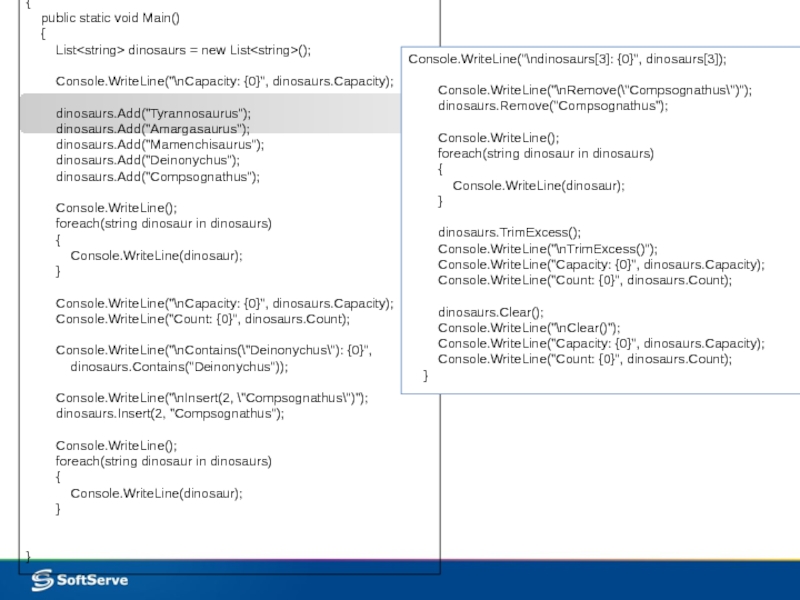- Главная
- Разное
- Дизайн
- Бизнес и предпринимательство
- Аналитика
- Образование
- Развлечения
- Красота и здоровье
- Финансы
- Государство
- Путешествия
- Спорт
- Недвижимость
- Армия
- Графика
- Культурология
- Еда и кулинария
- Лингвистика
- Английский язык
- Астрономия
- Алгебра
- Биология
- География
- Детские презентации
- Информатика
- История
- Литература
- Маркетинг
- Математика
- Медицина
- Менеджмент
- Музыка
- МХК
- Немецкий язык
- ОБЖ
- Обществознание
- Окружающий мир
- Педагогика
- Русский язык
- Технология
- Физика
- Философия
- Химия
- Шаблоны, картинки для презентаций
- Экология
- Экономика
- Юриспруденция
C# Collections. Generic Collections презентация
Содержание
- 1. C# Collections. Generic Collections
- 2. Agenda Array System.Collections
- 3. Array is a data structure that contains
- 4. int[] a = new int[5]; int [,]
- 5. Multidimensional arrays: string [ , ] names
- 6. Array. Benefits. Limitations Benefits of Arrays:
- 7. System.Collections. ArrayList System.Collections namespace ArrayList, HashTable, SortedList,
- 8. ArrayList is a special array that provides
- 9. ArrayList services public class ArrayList : IList,
- 10. ArrayList. Benefits and Limitation Benefits of ArrayList:
- 11. Stack Stack: last-in-first-out
- 12. Queue Queue: first-in-first-out using System.Collections;
- 13. Hashtable Represents a collection of key/value pairs
- 14. Hashtable Limitations of Hashtable: Performance and speed:
- 15. SortedList Represents a collection of key/value pairs
- 16. [SerializableAttribute] [ComVisibleAttribute(true)] public class SortedList
- 17. Collections. Drawbacks No type checking enforcement at
- 18. System.Collections.Generic Open constructed types Classes defined
- 19. List List generic class: [SerializableAttribute] public
- 20. Methods such as BinarySearch and Sort use
- 21. using System; using System.Collections.Generic; public class
- 22. Questions?
Слайд 1C# Collections.
Generic Collections
SoftServe University
17/09/2014 by A. Korkuna
Reviewed by Mykola Kushnir
Слайд 2Agenda
Array
System.Collections
Hashtables
Stack, Queue
SortedList
Collection Interfaces
System.Collections.Generic
List
Слайд 3Array is a data structure that contains several variables of the
type [ ] arrayName;
Array has the following properties:
array can be Single-dimensional, Multidimensional or Jagged.
The default value of numeric array elements are set to zero, and reference elements are set to null.
Arrays are zero indexed: an array with n elements is indexed from 0 to n-1.
Array elements can be of any type, including an array type.
Array types are reference types derived from the abstract base type Array. It implements IEnumerable and IEnumerable<(Of <(T>)>), for using in foreach
Array
Слайд 4int[] a = new int[5];
int [,] myMatrix=new int [6,8];
a[0] = 17;
a[1]
int x = a[1];
int l = a.Length;
Array. Examples
bool[] a = new bool[10];
int[] b = new int[5];
int[] c = new int[5] { 48, 2, 55, 17, 7 };
int [] ages={5,6,8,9,2,0};
Слайд 5Multidimensional arrays:
string [ , ] names = new string[5,4];
Array-of-arrays (jagged):
byte
scores[i] = new byte[4];
}
Three-dimensional rectangular array:
int [ , , ] buttons = new int [ 4, 5, 3];
Array. Examples
Слайд 6 Array. Benefits. Limitations
Benefits of Arrays:
Easy to use: arrays are used
Fast to change elements.
Fast to move through elements: Because an array is stored continuously in memory, it's quick and easy to cycle through the elements one-by-one from start to finish in a loop.
You can specify the type of the elements: When you create an array, you can define the datatype.
Limitations of Arrays:
Fixed size: Once you have created an array, it will not automatically items onto the end.
Inserting elements mid-way into a filled array is difficult.
Слайд 7System.Collections. ArrayList
System.Collections namespace
ArrayList, HashTable, SortedList, Queue, Stack:
A collection can contain an
Elements of a collection do not have to share the same datatype.
An object's position in a collection can change whenever a change occurs in the whole, herefore, the position of a specific object in the collection can vary.
Слайд 8ArrayList is a special array that provides us with some functionality
We can dynamically resize it by simply adding and removing elements.
using System.Collections;
class Department
{
ArrayList employees = new ArrayList();
...
}
create ArrayList
to store Employees
array of object references
ArrayList
object
employees
ArrayList
Слайд 9ArrayList services
public class ArrayList : IList, ICloneable
{
int Add (object
void Insert(int index, object value) ...
void Remove (object value) ...
void RemoveAt(int index) ...
void Clear () ...
bool Contains(object value) ...
int IndexOf (object value) ...
object this[int index] { get... set.. }
int Capacity { get... set... }
void TrimToSize() //minimize memory
...
}
control of memory
in underlying array
add new elements
remove
containment testing
read/write existing element
Слайд 10ArrayList. Benefits and Limitation
Benefits of ArrayList:
Supports automatic resizing.
Inserts elements: An
Flexibility when removing elements.
Easy to use.
Limitation of ArrayLists:
There is one major limitation to an ArrayList: speed.
The flexibility of an ArrayList comes at a cost, and since memory allocation is a very expensive business the fixed structure of the simple array makes it a lot faster to work with.
Слайд 12Queue
Queue: first-in-first-out
using System.Collections;
class Watcher
{
Queue events = new Queue();
...
}
create Queue
to
Слайд 13Hashtable
Represents a collection of key/value pairs that are organized based on
The objects used as keys must override the GetHashCode method and the Equals method.
Benefits of Hashtable:
Non-numeric indexes allowed. Key can be numeric, textual, or even in form of a date. But can’t be null reference.
Easy inserting elements.
Easy removing elements.
Fast lookup.
Hashtable ages = new Hashtable();
ages["Ann"] = 27;
ages["Bob"] = 32;
ages.Add("Tom", 15);
ages["Ann"] = 28;
int a = (int)ages["Ann"];
Слайд 14Hashtable
Limitations of Hashtable:
Performance and speed: Hashtable objects are slower to update
Keys must be unique: An array automatically keeps the index values unique. In a Hastable we must monitor the key uniqueness.
No useful sorting: The items in a Hashtable are sorted internally to make it easy to find objects very quickly. It's not done by keys or values, the items may as well not be sorted at all.
Hashtable ages = new Hashtable();
ages["Ann"] = 27;
ages["Bob"] = 32;
ages["Tom"] = 15;
foreach (DictionaryEntry entry in ages)
{
string name = (string)entry.Key;
int age = (int) entry.Value;
...
}
enumerate entries
get key and value
Слайд 15SortedList
Represents a collection of key/value pairs that are sorted by the
Are accessible by key and by index.
A SortedList object internally maintains two arrays to store the elements of the list
Use the new keyword when creating the object. Each adding item is automatically inserted in the correct position in the list, according to a specific IComparer implementation .
SortedList stlShippers = new SortedList();
stlShippers["cp"]="Canada Post";
stlShippers["fe"]="Federal Express";
stlShippers["us"]="United State Postal Service";
foreach (DictionaryEntry de in stlShippers)
{
Console.WriteLine("Key = {0}, Value = {1}", de.Key, de.Value);
}
Слайд 16[SerializableAttribute]
[ComVisibleAttribute(true)]
public class SortedList : IDictionary,
IEnumerable,
ICloneable
{…}
SortedList
Слайд 17Collections. Drawbacks
No type checking enforcement at compile time
Doesn’t prevent adding unwanted
Can lead to difficult to troubleshoot issues
Runtime errors!
All items are stored as objects
Must be cast going in and coming out
Performance overhead of boxing and unboxing specific types
ArrayList a = new ArrayList();
int x = 7;
a.Add(x);
int y = (int)a[0];
boxed
unboxed
Слайд 18System.Collections.Generic
Open constructed types
Classes defined without a specific type
Type is specified
Provides type safety at compile time
System.Collections.Generic System.Collections
List
Dictionary
SortedList
Stack
Queue
LinkedList
IList
IDictionary
ICollection
IEnumerator
IEnumerable
IComparer
IComparable
Слайд 19List
List generic class:
[SerializableAttribute]
public class List : IList, ICollection,
IEnumerable, IList,
The List class is the generic equivalent of the ArrayList class. It implements the IList generic interface using an array whose size is dynamically increased as required.
The List class uses both an equality comparer and an ordering comparer.
Methods such as Contains, IndexOf, LastIndexOf, and Remove use an equality comparer for the list elements.
If type T implements the IEquatable generic interface, then the equality comparer is the Equals method of that interface; otherwise, the default equality comparer is Object.Equals(Object).
Слайд 20Methods such as BinarySearch and Sort use an ordering comparer for
The List is not guaranteed to be sorted. You must sort the List before performing operations (such as BinarySearch) that require the List to be sorted.
Elements in this collection can be accessed using an integer index. Indexes in this collection are zero-based.
List accepts a null reference as a valid value for reference types and allows duplicate elements.
List
Слайд 21using System;
using System.Collections.Generic;
public class Example
{
public static void Main()
List
Console.WriteLine("\nCapacity: {0}", dinosaurs.Capacity);
dinosaurs.Add("Tyrannosaurus");
dinosaurs.Add("Amargasaurus");
dinosaurs.Add("Mamenchisaurus");
dinosaurs.Add("Deinonychus");
dinosaurs.Add("Compsognathus");
Console.WriteLine();
foreach(string dinosaur in dinosaurs)
{
Console.WriteLine(dinosaur);
}
Console.WriteLine("\nCapacity: {0}", dinosaurs.Capacity);
Console.WriteLine("Count: {0}", dinosaurs.Count);
Console.WriteLine("\nContains(\"Deinonychus\"): {0}",
dinosaurs.Contains("Deinonychus"));
Console.WriteLine("\nInsert(2, \"Compsognathus\")");
dinosaurs.Insert(2, "Compsognathus");
Console.WriteLine();
foreach(string dinosaur in dinosaurs)
{
Console.WriteLine(dinosaur);
}
}
Console.WriteLine("\ndinosaurs[3]: {0}", dinosaurs[3]);
Console.WriteLine("\nRemove(\"Compsognathus\")");
dinosaurs.Remove("Compsognathus");
Console.WriteLine();
foreach(string dinosaur in dinosaurs)
{
Console.WriteLine(dinosaur);
}
dinosaurs.TrimExcess();
Console.WriteLine("\nTrimExcess()");
Console.WriteLine("Capacity: {0}", dinosaurs.Capacity);
Console.WriteLine("Count: {0}", dinosaurs.Count);
dinosaurs.Clear();
Console.WriteLine("\nClear()");
Console.WriteLine("Capacity: {0}", dinosaurs.Capacity);
Console.WriteLine("Count: {0}", dinosaurs.Count);
}



![int[] a = new int[5];int [,] myMatrix=new int [6,8];a[0] = 17;a[1] = 32;int x =](/img/tmb/5/470985/750ff348381f9c410b5161ef132ddf0b-800x.jpg)
![Multidimensional arrays: string [ , ] names = new string[5,4]; Array-of-arrays (jagged): byte [ ][ ] scores](/img/tmb/5/470985/5b83d268fd18f775150317c5cf5b3f5d-800x.jpg)


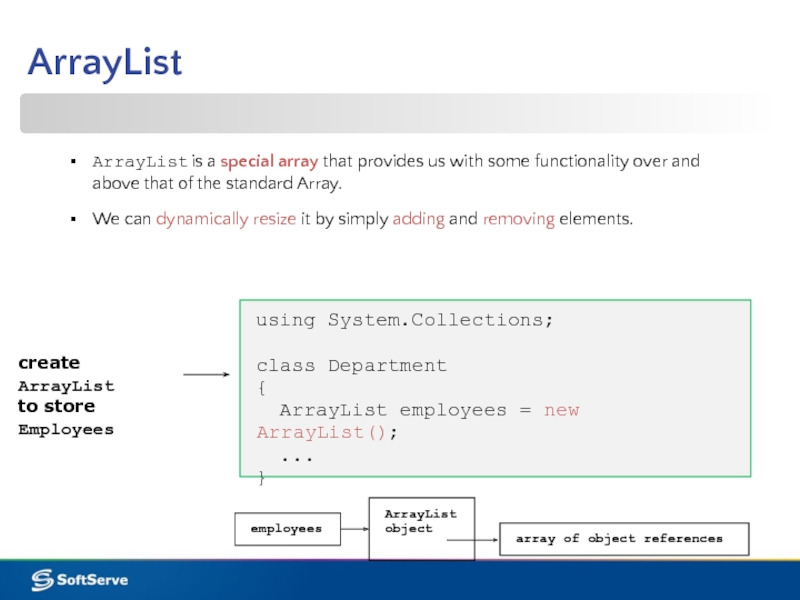

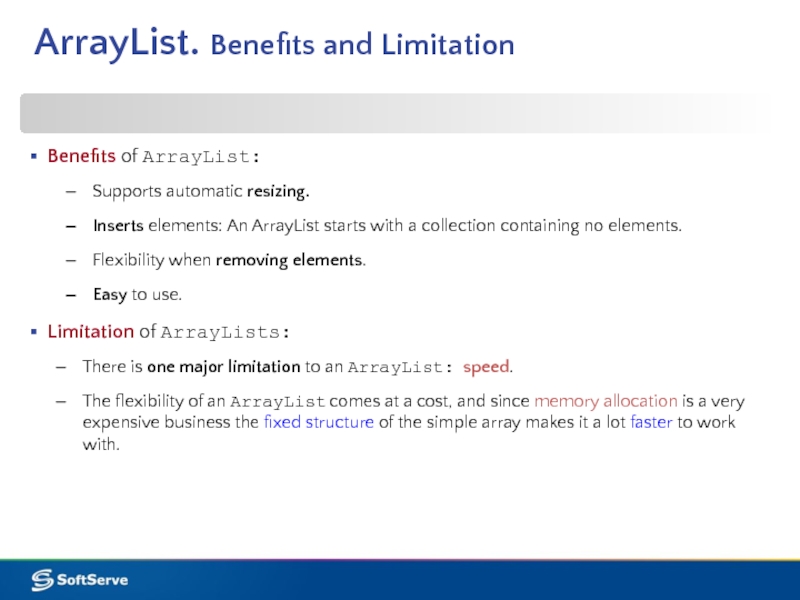

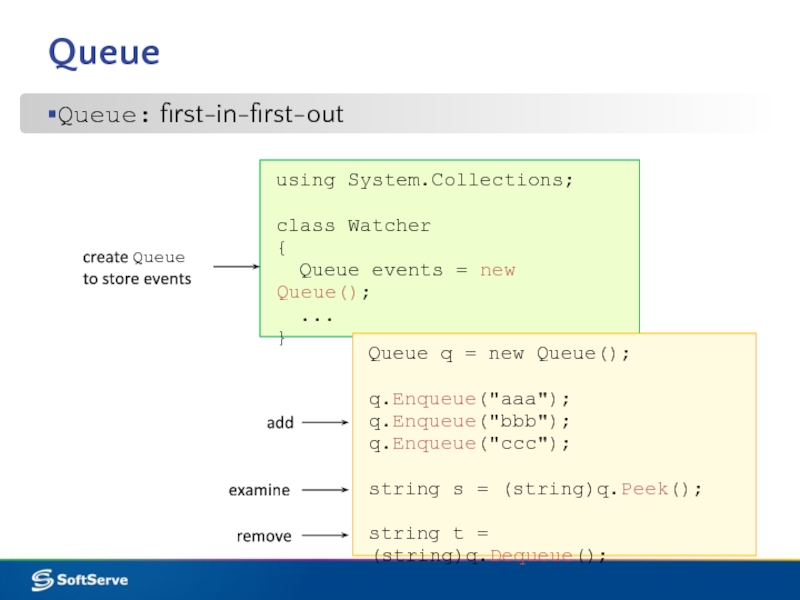
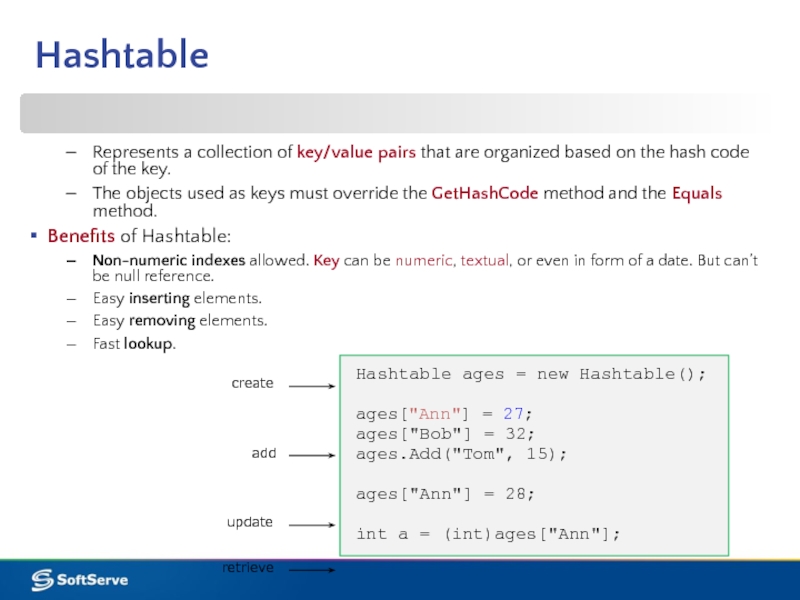


![[SerializableAttribute] [ComVisibleAttribute(true)] public class SortedList : IDictionary, ICollection, IEnumerable, ICloneable{…}SortedList](/img/tmb/5/470985/9512ee1ecae891aa7223767c3363703f-800x.jpg)


![ListList generic class: [SerializableAttribute] public class List : IList, ICollection, IEnumerable, IList, ICollection, IenumerableThe List class](/img/tmb/5/470985/4821699d7f4e5820c3a89fabd31a6bc7-800x.jpg)

